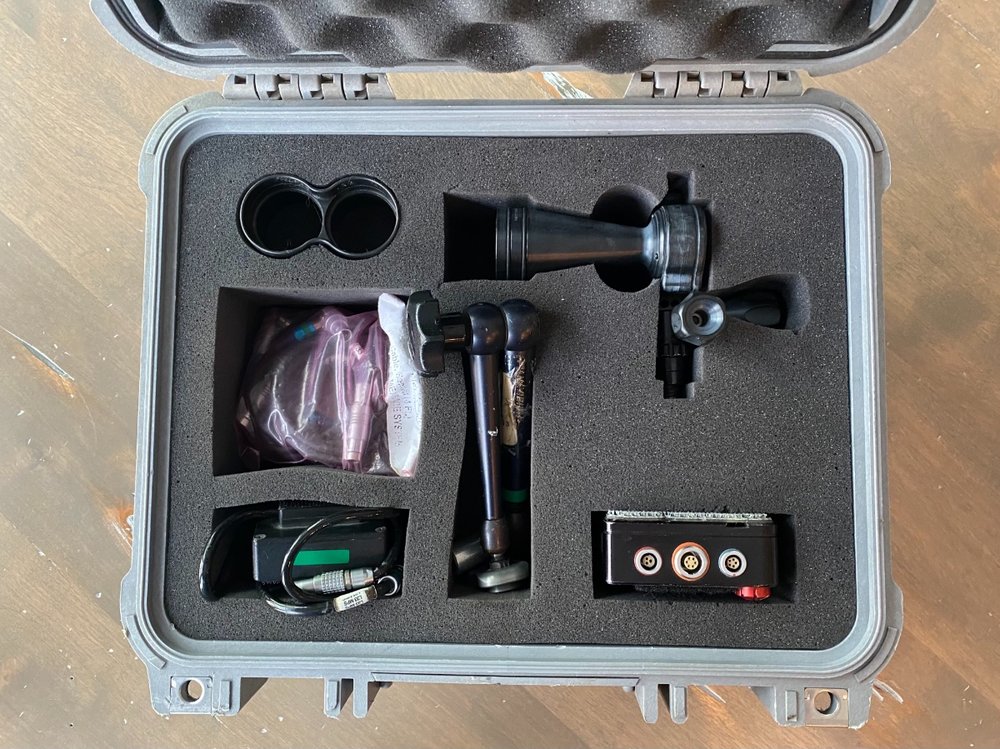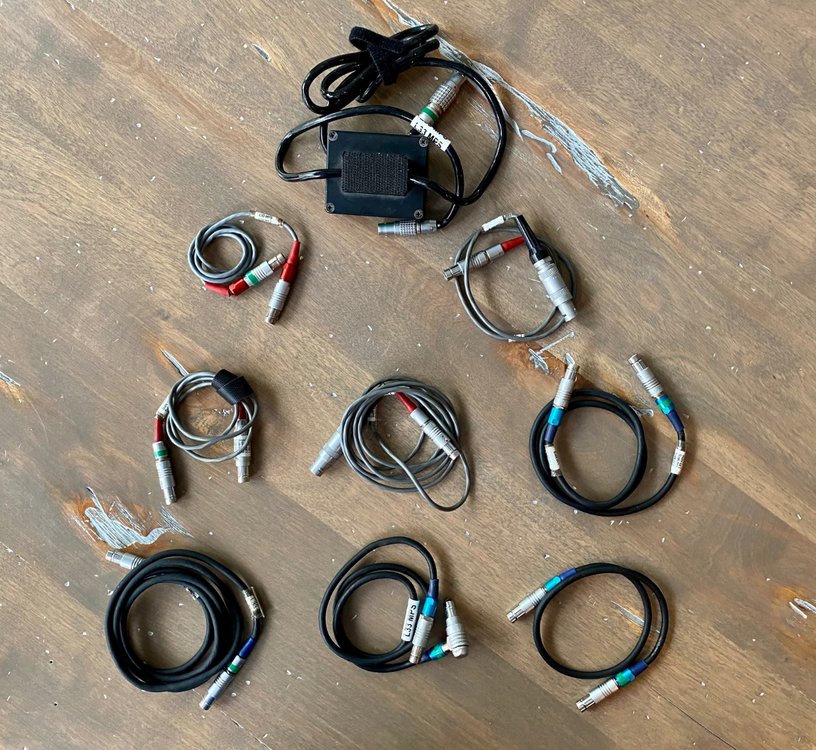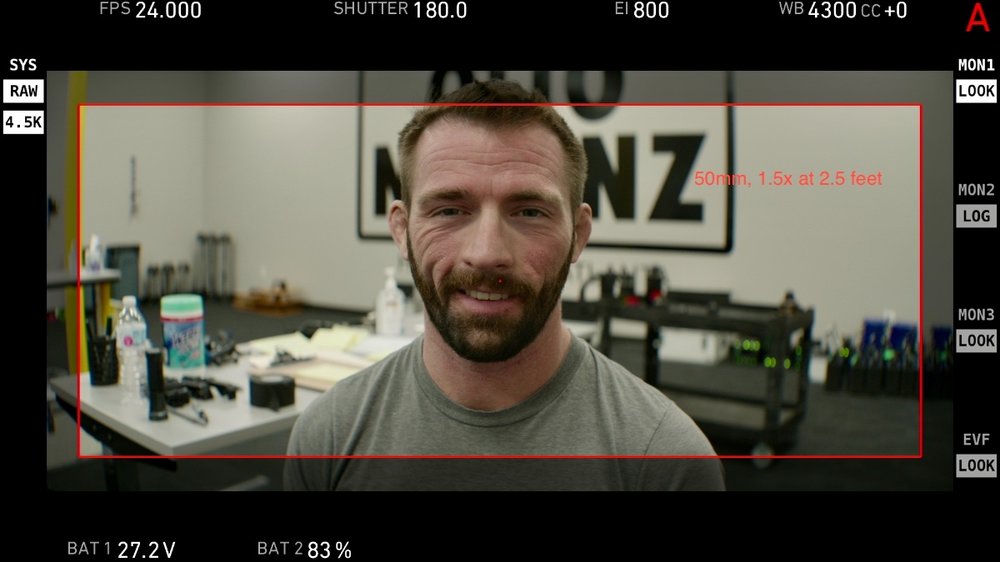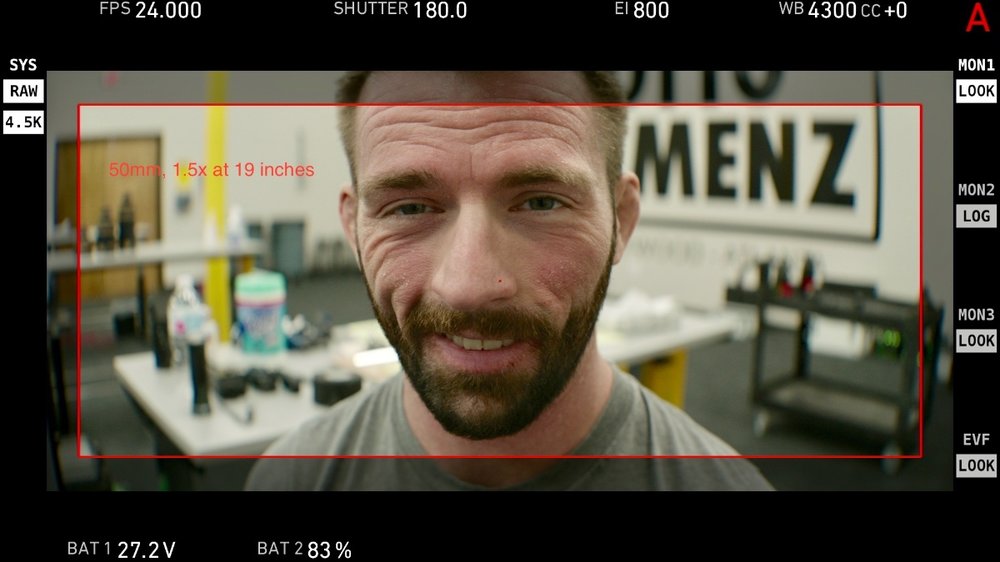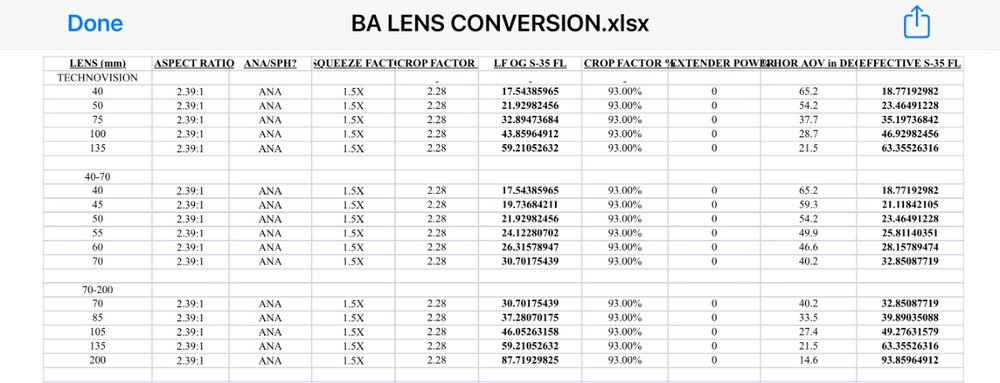-
Posts
1,004 -
Joined
-
Last visited
Everything posted by Gregory Irwin
-
THE FIGHTER was completely hand held and steadicam. I now remember due to using Master Primes, the hand held Penelope was extremely nose heavy. I had the on board monitor armed all the way back to help balance the camera on the shoulder. On steadicam, the coaxial mags played havoc with the side to side balancing while rolling. The balance would change rapidly while the film traveled from feed to take up. If steadicam operator, Geoff Haley didn’t have the ability to balance on the fly, we’d be in big trouble! G
-
Hi David! It’s been quite a few years and I’m trying to remember everything we didn’t care for. First off, the camera is way too heavy for its size. I expect smaller cameras to be much more maneuverable compared with larger cameras. The video taps were dark and muddy in low light conditions. The viewing system was the same. You have to realize that we are more used to the brighter light paths with Panavision and Arri. Finally, there is no real estate on the camera bodies for the accessories we require for big feature filmmaking like Preston’s, Cinetapes, transmitters and on board monitors. We managed but it wasn’t pretty! It did take nice images in the end. Cheers!
-
I used the first three that came to the United States through Abel Cine in New York in 2009 on a feature film called “The Fighter”. They could possibly still have them but I would think most likely not. I honestly didn’t think very highly of the camera. G
-
I am selling my personal cinetape that worked on the “A” camera for such feature film hits like JOKER, STAR TREK BEYOND, FATE OF THE FURIOUS, INTERSTELLAR as well as many more. Meticulously maintained and only worked with me. No one else! $4,000.00 USD! The kit includes: * 1 Sensor Tubes * 1 Display * 2 Fisher 3 pin power cables * 2 Panavision 2 pin LEMO cables * 4 sensor cables of different lengths. * 1 Preston Interface cable * 1 mounting arm *1 Extension Tubes * 1 Pelican case with custom cutouts Please message me if interested.
-
You may want to consider a clip-on rain deflector as well so you don’t end up with a lens and image covered in water. G
-
You may have to look in Austin or Dallas. G
-
Maybe you’re right about glued ground glasses with some cameras Simon but none of the major camera manufacturers like Panavision or Arri does that. Panavision’s ground glass simply slides into a frame, while Arri’s is loaded into a spring loaded frame. We would always need to pull them out regularly for cleaning or changing formats. As for checking the accuracy of ground glass focus, there is a very simple test for that. 1. Take a sheet of newspaper with all print (no pictures) on it - the classified section is good for this. Any large sheet of paper with rows of fine print will work. 2. In the middle of the page, draw a line through a row of print. Make your line with a colored sharpie such as red so it stands out against the black print. 3. Take the sheet of paper, tape it on a flat wall with the print oriented vertically, NOT horizontally. 4. Take your camera with a long lens, wide open at minimum focus, in order to get shallow depth of field. Place the camera on an extreme raking angle towards the news print, placing the vertical red line right in the middle of the frame. Fill the frame with the rows of print. Eye focus carefully on the red line so it is sharp and you can see the other rows falling off out of focus fore and aft in your frame. Roll camera. 5. When you view the footage and the red line is sharp, your ground glass is properly collimated. If it’s not sharp, it’s not. Now you know if you can trust eye focus or not. G
-
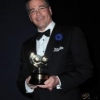
Christmas/party Lights Flicker
Gregory Irwin replied to Ben Kahn's topic in Lighting for Film & Video
Try experimenting with different shutter angles. You should be able to find one that reduces or eliminates the flicker. G -

The Complexities of Large Formats and Lenses
Gregory Irwin replied to Gregory Irwin's topic in Lenses & Lens Accessories
In my experience, we don’t restripe lenses. Most of the variations are slight and we can instantly see them on a calibrated monitor and compensate if necessary. There are so many other variables that can also affect exposure, you can drive yourself crazy. Keep it stupid simple. G -

The Complexities of Large Formats and Lenses
Gregory Irwin replied to Gregory Irwin's topic in Lenses & Lens Accessories
We are definitely recording on the full sensor, 1.44. The only aspect ratio we care about is the 2.39. We don’t really refer to the desqueeze. But you do have a keen eye! The lenses do have a very slight horizontal stretch. But faces are shown to be accurate. No anamorphic mumps. G -

The Complexities of Large Formats and Lenses
Gregory Irwin replied to Gregory Irwin's topic in Lenses & Lens Accessories
What’s crazy to me is, after all the variables are calculated, how wide this anamorphic format ends up on the large format sensor. Pictured are 2 images made with my custom Technovision 1.5x, 50mm Close Focus lens at 19 inches (minimum focus) and 2.5 feet. The aspect ratio is 2.39:1 with a 93% extraction on the Alexa LF. G -

The Complexities of Large Formats and Lenses
Gregory Irwin replied to Gregory Irwin's topic in Lenses & Lens Accessories
We will use the effective focal lengths for on-set reference only. Since the “real” focal lengths don’t tell us the entire story of what’s wider or tighter than the other, a simpler and much smaller version of my chart will be laminated and attached to our ID lanyards for quick reference. As far as VFX is concerned, I would believe that they will use the actual, non-compensated focal length numbers for their purposes. Once I have all of the selected lenses assembled for principle photography, I will map each lens individually on the lens grid during camera prep. One note regarding the final set of selected lenses; before I do anything with them for any purposes for the movie, I will need to detune all of the non-Technovision lenses to match the Technovision lenses. Color, contrast and resolution will need manipulation in order to achieve a matched set. G -

The Complexities of Large Formats and Lenses
Gregory Irwin replied to Gregory Irwin's topic in Lenses & Lens Accessories
Here is a portion of my lens conversation chart. This section illustrates 1.5x anamorphic to Super 35 spherical. For example, the 40mm anamorphic would become the equivalent of a 19mm in S35 spherical terms after calculating crop factor and extraction percentage (crop factor %) based on horizontal angle of view. -

The Complexities of Large Formats and Lenses
Gregory Irwin replied to Gregory Irwin's topic in Lenses & Lens Accessories
The VFX work on this picture is extremely extensive. In addition to the “traditional “ VFX work, we will also be employing the Volume. I finally decided on a method for the lens reference. Due to a variety of variables such as anamorphic vs. spherical, squeeze factors, crop factors, extraction percentages, as well as expander powers, we can calculate the trigonometry to convert the different types and focal lengths of lenses (with the 2.39:1 aspect ratio throughout on the Alexa LF OG sensor) to the spherical, super 35mm focal length equivalents. This will be based on horizontal angle of view. A good example of why this is so complicated, is a 1.5x anamorphic 40mm is much wider than a 2x anamorphic 28mm. In order to get wider than the 40mm, I had to go to the Zeiss, Ultraprime 8R. There may be one other spherical focal length that was also a tad wider but for now, I can’t remember. After studying over 200 lenses, it becomes a blur. Once I finish with the spreadsheet, I’d be happy to share the results. G -

The Complexities of Large Formats and Lenses
Gregory Irwin replied to Gregory Irwin's topic in Lenses & Lens Accessories
Even as that may be, I need to have a comprehensive understanding of the angles of view along with VFX’s need for the same. -

The Complexities of Large Formats and Lenses
Gregory Irwin replied to Gregory Irwin's topic in Lenses & Lens Accessories
Hi Tyler, The set is currently comprised of 40, 50, 75, 100 & 135mm. There are also 2 zooms, 40-70 and 70-200. In addition, per our request, P&S made separately 2 close focus lenses, 40mm & 50mm to 16inches. G -

The Complexities of Large Formats and Lenses
Gregory Irwin replied to Gregory Irwin's topic in Lenses & Lens Accessories
Do you have any reference material that may be relevant to me from the Todd-AO way of listing their lenses? I would much appreciate that. Possibly email to me? Thanks David! G -

The Complexities of Large Formats and Lenses
Gregory Irwin replied to Gregory Irwin's topic in Lenses & Lens Accessories
Ay, there’s the rub. ? -

The Complexities of Large Formats and Lenses
Gregory Irwin replied to Gregory Irwin's topic in Lenses & Lens Accessories
I completely understand what your concern was David. Sometimes my brain goes much faster than my writing and I can be unclear. I need to learn to slow down and be much more concisely understood. With regards to the new Technovision, 1.5x anamorphic lenses, P&S Technik did a very good job recreating the 1960’s Technovision look. The color, contrast, fall off and bokeh has a beautiful, nostalgic feel to them. And they cover large sensors! I love Larry Sher’s bold idea to go with a period look for a high tech, comic book, super hero movie. Again, gutsy like his decision making was on JOKER. G -

The Complexities of Large Formats and Lenses
Gregory Irwin replied to Gregory Irwin's topic in Lenses & Lens Accessories
As Shakespeare’s Hamlet once pondered, “Ay, there’s the rub”. I sympathize with what you wrote Dom. I believe in my case, I went into this project thinking I knew the questions that needed answers. Once I arrived in Los Angeles and began my dive into the lenses at Otto Nemenz International, I quickly realized that in order to understand my goals, I needed to figure out what the real question was! I was a bit dumbfounded for a while that I didn’t already know this! With all of the variables that have already been mentioned in the earlier posts, I believe the real question is how do we create a common language, that we can all understand to quickly refer to the effective focal lengths of the different lenses? Is there a way to strip away all of the mumbo jumbo and confusion of different squeeze factors, expander powers, crop factors, spherical vs. anamorphic, etc (it’s now time for my head to explode...) and have a common basis for the nomenclature of angle of view? In your post above Dom, I would propose we speak in terms of “angle of view” as opposed to “field of view” since the latter changes with distance. I’m considering translating all of the above to 35mm terms since we all understand those. I encourage any feedback! G -

The Complexities of Large Formats and Lenses
Gregory Irwin replied to Gregory Irwin's topic in Lenses & Lens Accessories
You’re absolutely correct about the squeeze factors. The Technovision was 2x and the only reason ours is 1.5x is to make them full frame. Thanks David! G -
I’m currently prepping and testing various lenses for my next movie, BLACK ADAM for Warner Bros. I am constantly reminded and amazed at how much more complicated incorporating lenses of different formats and sizes has become. For example, I am employing a brand new series of 1.5x anamorphic lenses that were built for us and our show by P&S Techique in Germany. These lenses are replicating the 1960’s Technovision look that was made famous by Storaro and others years ago but in a modern lens construction. Since it’s only a five focal length set, I need to supplement additional focal lengths with 2x anamorphic and spherical lenses to create a complete set. And this is where it gets complicated. I’m tasked to create a cohesive lens set made up of full frame lenses that cover the Arri LF Open Gate sensor as well as 35mm (non full frame) lenses that require a crop factor so we don’t vignette within the aspect ratio of 2.39:1. All of the different lens manufacturers and designs require a different extraction percentage thus changing the effective angle of view. This results in a mathematical change of focal length. For example, my Technovision, 1.5x 40mm has a much wider angle of view than my Master Anamorphic 2x 28mm or my spherical Leica 19mm. I began with going through almost 200 plus lenses and have now reduced the possible candidates to about 40 lenses. My goal is to have a shooting set of about 20 lenses with the knowledge that we would actually use around 6 or 7 lenses to shoot the majority of the picture. I’ll update this thread as I work through this process for the next several weeks. G
-

The Business end of Being an AC
Gregory Irwin replied to Alpha Mthembu's topic in Camera Assistant / DIT & Gear
Hey there! First and foremost, be ethical with what you are renting. Rent the gear that is needed. Don’t rent gear that is unnecessary or doesn’t even exist just to make more money. That’s a death sentence for the long run. Transparency is very important for the production to trust renting gear from a previously unknown vendor. Also, keep your gear up to date and maintained. I rent a lot of gear, not only to my shows but to any show that wishes to do business with my gear, through my registered corporation, Latitude 33 Motion Picture Services. That maintains a business relationship between the production and the gear placing a layer of separation between me as an employee and a vendor. My rental prices match the primary vendor’s pricing such as what Panavision charges. My business income is treated separately from my employment income. Also, a Rental Agreement is required for the production to sign along with certificates of insurance. The agreement stipulates the terms and conditions of rental. Finally, as for going into partnerships with other ACs, I would caution you. Anything that involves someone else’s income can spoil friendships when things go wrong. And believe me - many things can go wrong. Thus for the past 32 years, I’ve done this on my own. It’s the smart play for me. Good luck with your enterprise! G- 1 reply
-
- 1
-

-

how to learn to be a focus puller?
Gregory Irwin replied to Abdul Rahman Jamous's topic in Camera Assistant / DIT & Gear
It's fun to read all of the above. I've been focus pulling for so long (42 years) that I've forgotten much of what it takes to be good and instinctive for the job. Like I have stated before, it takes many years of struggling and practice to achieve a proficiency for the craft. Only after you can get beyond the academics and mechanics of focus pulling can your mind be free to concentrate on the creative aspects of the art. It's very liberating once that happens and enjoyable! At this stage of my career, I really don't even touch the cameras anymore. My extremely talented and qualified team takes care of that these days. This allows me to fully commit myself to servicing the cinematography to the best of my ability via focus and running the business side of the camera department with the cinematographer, the producers and the studio. I wish you all the best as you develop into superstar focus pullers! G



